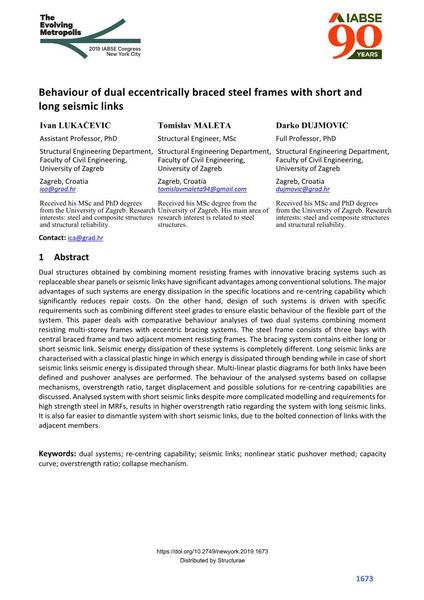Behaviour of dual eccentrically braced steel frames with short and long seismic links

|
|
|||||||||||
Détails bibliographiques
| Auteur(s): |
Ivan Lukačević
(Structural Engineering Department, Faculty of Civil Engineering, University of Zagreb)
Tomislav Maleta (Structural Engineering Department, Faculty of Civil Engineering, University of Zagreb) Darko Dujmovic (Structural Engineering Department, Faculty of Civil Engineering, University of Zagreb) |
||||
|---|---|---|---|---|---|
| Médium: | papier de conférence | ||||
| Langue(s): | anglais | ||||
| Conférence: | IABSE Congress: The Evolving Metropolis, New York, NY, USA, 4-6 September 2019 | ||||
| Publié dans: | The Evolving Metropolis | ||||
|
|||||
| Page(s): | 1673-1680 | ||||
| Nombre total de pages (du PDF): | 8 | ||||
| DOI: | 10.2749/newyork.2019.1673 | ||||
| Abstrait: |
Dual structures obtained by combining moment resisting frames with innovative bracing systems such as replaceable shear panels or seismic links have significant advantages among conventional solutions. The major advantages of such systems are energy dissipation in the specific locations and re-centring capability which significantly reduces repair costs. On the other hand, design of such systems is driven with specific requirements such as combining different steel grades to ensure elastic behaviour of the flexible part of the system. This paper deals with comparative behaviour analyses of two dual systems combining moment resisting multi-storey frames with eccentric bracing systems. The steel frame consists of three bays with central braced frame and two adjacent moment resisting frames. The bracing system contains either long or short seismic link. Seismic energy dissipation of these systems is completely different. Long seismic links are characterised with a classical plastic hinge in which energy is dissipated through bending while in case of short seismic links seismic energy is dissipated through shear. Multi-linear plastic diagrams for both links have been defined and pushover analyses are performed. The behaviour of the analysed systems based on collapse mechanisms, overstrength ratio, target displacement and possible solutions for re-centring capabilities are discussed. Analysed system with short seismic links despite more complicated modelling and requirements for high strength steel in MRFs, results in higher overstrength ratio regarding the system with long seismic links. It is also far easier to dismantle system with short seismic links, due to the bolted connection of links with the adjacent members. |
||||
